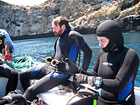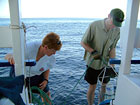

 | |||||||||||||||
|
|
Journals 2007/2008Beth Jewell
January 16, 2008 Laura Dee, an undergraduate student from Brown spends most of her dive time completing fish surveys and sea urchin quads. She starts each fish transect by laying out a 30-meter tape along a wall. As she swims along the length of the tape, she counts the number and types of fish she can see up, down, and out. The study is primarily interested in those fish that eat barnacles and sea urchins.
Laura is studying the frequency and size of sea urchins found in the rubble and along the sea wall (called a size frequency distribution of eucidaris, the pencil urchin native to the Galápagos). At each of these locations, she uses a 50 x 50 cm quadrant to define her study area. Picking up the rocks in the rubble, she looks for sea urchins, measuring and counting them. Along the wall she looks into the cracks for sea urchins, measuring and counting these as well. So far, she thinks that the rubble contains the smaller sea urchins, possibly because it provides protection from predators. Laura is collecting data for and working on a senior thesis with Jon Witman. She is examining the potential spatial and temporal refuges for the pencil urchin from predation, particularly from hogfish. To investigate this topic, she will use the size frequency distribution information from the rubble versus wall quadrants and data on day versus night hogfish abundance patterns taken from the time-lapse images. From the five time-lapse trials that she has analyzed, a distinct pattern has emerged from the hogfish abundance counts suggesting that hogfish are not active (asleep?) after dusk until around 6:30-7 am.
We had a good deal of cruising time today, traveling from one site to another. I spent a good deal of it on the bow or in the bridge with the captain. He was a gold mine of information. He told me that this is typically the rainy season here and about 2-3 °C warmer than what we are experiencing. Because of the lower temperatures and lack of rain, the islands are brown and not tropical looking. The cacti are suffering and the tortoises that rely on them are dying. My interest was really piqued when he told that sperm whales are common in these channels. I didn't have any luck spotting a sperm whale but did see some other interesting organisms. At one point 5-6 dolphins joined us to bow ride. They didn't stay very long and I was sad to see them leave. Occasionally we would pass a turtle resting at the surface but once the boat came along side of them, they dove down. 2 flying fish jumped from the water, I was surprised not to see more of them. I finally saw the much talked about manta ray jump from the water. He was off in the distance a bit but to see this huge fish do 2-3 360 degrees in every jump was totally amazing.
At each dive site we cast a CTD to obtain salinity and temperature profiles. These profiles are important in identifying upwelling, internal waves, and long-term temperature changes associated with El Niño and La Niña. A 60-meter rope is attached to the CTD and it is slowly lowered into the ocean. A computer records data every half second as the CTD is lowered and then brought back to the surface. This afternoon I helped Jim bring in the rope. Just as we were about to finish we were visited by a sea lion. The sea lion played around in front of us for several minutes, bobbing up and down before swimming off.
Jon Witman's dive notes for the day: |
||||||||||||||



